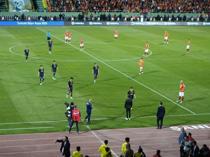Female athletes push to close sporting gender gap
LONDON - Reuters

Chinese wonder girl Ye Shiwen has won two gold medals at the 2012 Olympic Games. ABACA PRESS photo
The phenomenal speeds reached by the teenage Chinese swimmer Ye Shiwen at the 2012 Olympics are raising questions about whether the gap between men and women in sport may one day disappear.Ye, who has so far won two gold medals, clocked a time for the last, freestyle lap of her medley swim that rivalled the male champions.
There’s evidence to show the gender gap exists, yet the gap has been narrowing over the decades - so will women one day catch the men?
They’ll get close, says John Brewer, a professor of sports science at Britain’s University of Bedfordshire - but only in some events.
Women first took part in the Olympic Games in Paris in 1900, four years after the first Games of the modern era in Athens.
Female participation has increased steadily since then, with women accounting for around 45 percent of athletes at the 2012 Games, compared with 23 percent in Los Angeles in 1984 and just over 13 percent in Tokyo in 1964.
A study published in 2010 in the Journal of Sports Science and Medicine, which looked at the difference between men’s and women’s world records, found that the gap narrowed consistently until about 1983, then stabilised.
More fat, less muscle
The average difference between men and women is around 10 percent, but that ranges from 5.5 percent in the 800-meter freestyle swim to 18.8 percent in long jump.
Experts point to physiological differences between the two genders.
“Females tend to have more body fat, which makes them more buoyant in the water, and that can sometimes help in terms of speed,” said Alexis Colvin, assistant professor of orthopaedics at the Mount Sinai School of Medicine in New York. “But on the flip side, women have less muscle mass and power, so the effect is cancelled out.”
Men’s hearts are generally larger, allowing them to pump more blood for each heartbeat, and their lungs are able to take in more oxygen for each breath. The combination means their blood can take more oxygen to the muscles, making them stronger and more powerful.
The relative infancy of some disciplines for women and the Olympics means, however, that women could squeeze the gap as coaches, sports scientists and psychologists learn more about how to train, support and push women at elite level.
“Even though biology is responsible for a lot of things, we’re also learning a lot more about the most effective ways for women to train and recover,” Colvin told Reuters. “That might help us overcome some of the biological differences.”
Brewer thinks much of that women-specific knowledge has already been gained and implemented - something that could account for the rapid narrowing of the gender gap in some events in recent years.
“But while a very good female be able to beat a good male, at the highest level the very best females won’t be able to beat the very best males,” he said. “Sadly, in my view, the gap will never close completely.”
















